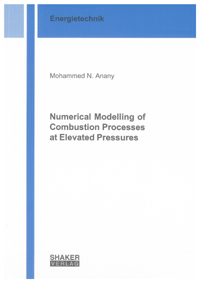
Catalogus : Recensies
Recensies

|
Mohammed N. Anany Numerical Modelling of Combustion Processes at Elevated Pressures ISBN: 978-3-8322-9204-1 Prijs: 48,80 € / 97,60 SFR |
|---|---|
| As more and more CO{sub 2} quantities are discharged into the atmosphere from flue gases due to fossil fuel combustion, increasing concerns over greenhouse gas emissions have caused extensive research to be directed to the field of new power generation cycles that enable CO{sub 2} capture and storage. Raising the pressure of the coal conversion enables economic separation of CO{sub 2}. Two technologies working at elevated pressures are, for example, the Integrated Gasification Combines Cycle (IGCC) technology and the pressurised oxy-fuel combustion power cycles. Both Technologies rely on conversion of coal at elevated pressures, and hence enabling the CO{sub 2} separation process. For the numerical simulation of such processes, it has been proven that global models of atmospheric char conversion are neither directly applicable nor extrapolatable for elevated-pressure atmospheres. Therefore, abandoning these global models of char conversion and developing more reliable mechanistic char gasification/combustion models is a key point in being able to successfully predict the char gasification/combustion processes taking place at elevated pressures for these new clean-coal technologies. Since oxygen is, by far, the most efficient oxidising agent, the principal aim of this work is to develop a mechanistic model for Char Burn-Out (CBO) that is capable of providing correct predictions of char oxidation rates for wide ranges of temperature and pressure. Hence, this work also contributes to the work being conducted on the char conversion modelling at elevated pressures. In order to validate the predictions of the model, the finite volume (FV) CFD combustion simulation code AIOLOS has been used. During the course of development of the coal conversion model, a non-dissipative SIMPLEC algorithm (Semi Implicit Method for Pressure Linked Equations Consistent) for non-staggered (collocated) grids has been developed, since its robustness has been proven to be higher than their SIMPLE counterpart. Furthermore, the applicability of the Allspeed methods to reactive flows has been tested showing the need of double-precision declaration of variables when working with Mach numbers approaching the limit of zero. The Allspeed method has proven to predict similar results as is its SIMPLE algorithm equivalent for low-speed flows. The method has not been tested (in this work) for combustion applications of high-speed flows, i.e. Mach numbers exceeding 0.3. Moreover, an implicit under-relaxation approach has been developed to stabilise the solution of the pressure-correction equations. This approach has proven to be successful at the initial stage of the iterative solution of the problem as it has shown a reduction of one order of magnitude in the pressure-correction residuals. The development of the elevated-pressure coal conversion model necessitated the introduction of an elevated pressure pyrolysis model. A single first order reaction kinetic rate has been adopted to predict devolatilisation of raw coal. The total volatile yield has been made achievable by creating a data base of 14 coals, on the van Krevelen (coalification) diagram, which range from anthracite to lignite coals, and whose total volatile yields are fixed by experiment. An interpolation technique was adopted afterwards to predict the total volatile yield of coals which are not directly obtainable from the data base. For tar yield predictions a correlational model was incorporated within the CFD code. The model correlates the tar yield to the elemental composition of the parent coal and to the system pressure applied. The mechanistic char burn-out model relies on a three-step char oxidation process in contrast to the well-known two-step chemisorption-desorption mechanism (Langmuir-Hinshelwood kinetics). The third reaction step represents a reaction between oxygen molecules and the already formed carbon-oxide complexes. The specific reaction rate of char oxidation has been modelled by means of the Extended Resistance Equation (ERE) which accounts for Boundary Layer Diffusion (BLD) effects as well as pore diffusion effects by using a reaction penetration factor that accounts for the contribution of the interior surface of the coal particle to the oxidation process. The predictions of the two-step extended resistance equation and the three-step one have been compared against the results of experiments conducted on a pressurised Entrained Flow Reactor (p-EFR). The comparison has reflected the successfulness of the three-step char oxidation mechanism of predicting a combustion rate enhancement as partial pressures of oxygen are increased. However, the two-step mechanism has predicted the wrong trend as pressure was increased for the pressure range reported by the experiment. (orig.) | |
| Bron: ETDE - Energy Database-production no.: DE10GE336 | |
| verder naar publicatie ... | |